If you're planning a visit, you're likely wondering about the weather in DC. What to wear outdoors? What to pack?
With so many great things to do in the great outdoors - such as our name-your-own-price walking tours - you need to make sure you're prepared for whatever the weather may bring.
Use this guide to make sure you know what the average day is like whenever you're vacationing in DC.
Average Weather in DC by Month
The weather in DC can be unpredictable but there are some common trends throughout the year.
The summer in DC is humid - meaning the air can be heavy and feel hotter.
February is usually the coldest month but there can be conversational snow in November or April.
It doesn't often snow in large amounts, though even the smallest amount can shut the city down.
Fear not, as there is usually at least one museum that can still open.
Thunderstorms are common in summer, and it rains often in Spring but DC rain storms come in waves.
The downpour may be heavy but it doesn't last long and you can usually wait it out under cover until it passes.
Weather in January
Morning lows in January are typically in the mid to upper 20s F (-2 to -3C) and low to mid-40s F in the afternoon (6 to 7C).
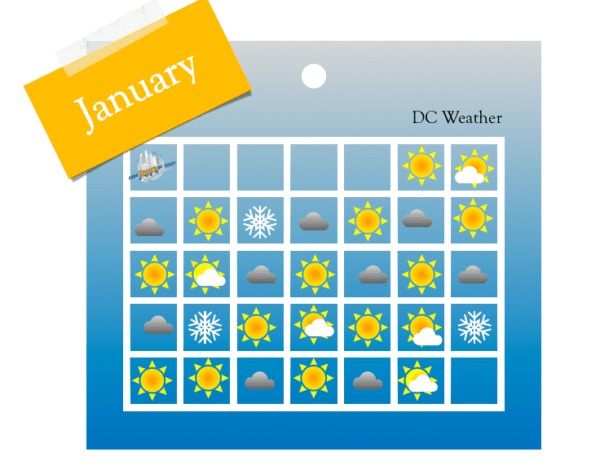
Expect morning lows to drop as low as the mid-teens on the coldest mornings (about -8C).
However, some of the warmer afternoons can go as warm as the upper 50s (14-15C).
Read our complete post about the weather in Washington, DC, in January for more information.
Weather in February
Early in the month, overnight lows are often in the mid to high 20s F (-2C), but towards the end of the month, they are more likely to be in the mid-30s F (+2C).
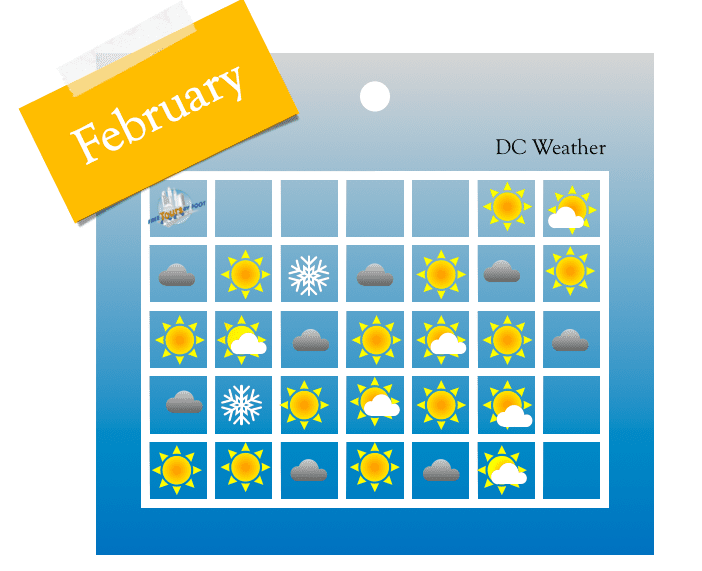
Early in the month, afternoon highs are typically in the mid-40s F (7-8C), warming to the lower 50s F (10-11C) later on.
More details are available on our page about the February weather in Washington, DC.
Weather in March
Early in March, daytime highs are typically in the low 50s F. (about 11 C).
Early in March, overnight lows are often in the low to mid-30s F (0–2 C), with a few morning lows of the mid–20s F (–3 C) or below.
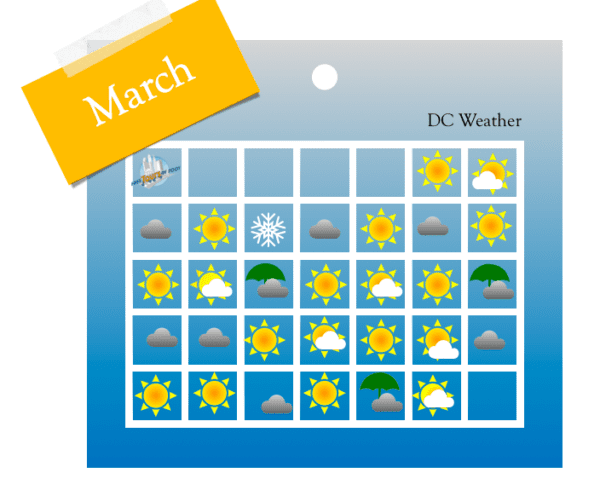
We provide a lot more detail in our full post covering the weather in Washington DC in March.
Weather in April
The morning lows in early April are typically in the low to mid-40s F (5-7 C), with a few mornings falling into the mid-30s F (1-2 C), while the afternoon highs are typically in the low 60s F. (16-17 C).
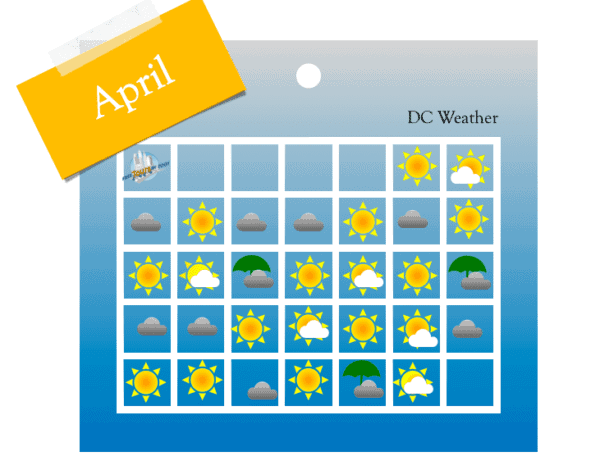
The morning lows warm to the low to mid-50s F (10-12 C) range as the month goes on, while the afternoon highs are most likely to reach the low to mid-70s F range (21-23 C).
For even more information, consider reading our full post on the weather in Washington DC in April.
Weather in May
Early in May, you may anticipate low to mid-50s F (10-12 C) for morning lows and low to mid-70s F (10-12) for afternoon highs (22-23 C).
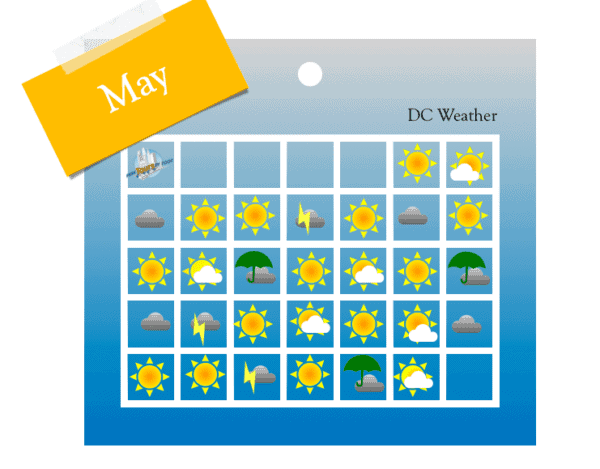
The morning low temperatures, however, will increase to the low to mid-60s F (16-17 C) by the end of this month, while the afternoon highs will average in the low 80s F (approximately 27 C), with a few days reaching the upper 80s F (31 C) or higher.
If you're looking for more details, make sure to read our post on the weather in Washington DC in May.
Weather in June
Early in June, morning low temperatures typically range from 15 to 17 degrees Fahrenheit (lower 60s to mid-50s C) (12-13C).
Early in the month, afternoon highs typically hover around 80F. (26-27C).
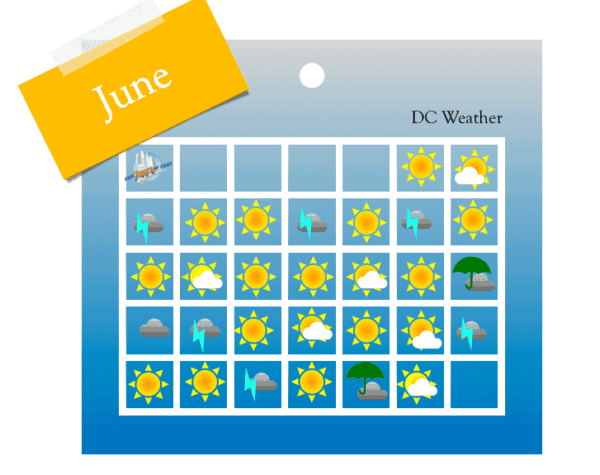
By the end of June, afternoon highs will typically reach the mid to upper 80s F (30-32 C), while morning and evening lows will drop to the upper 60s F to close to 70 F. (20-21 C).
For more details, read our full post about the weather in Washington DC in June.
Weather in July
On average, DC experiences 12–14 days in July with temperatures reaching or above 90°F (about 32°C), and roughly one in every two years with temperatures exceeding 100°F (about 37.8°C).
In the past, DC has experienced temperature extremes ranging from 54F (12.2 C) to 104F. (40 C).

On about 18–20 days in July, the skies are often sunny or at least partly sunny, with some rain typically falling on about 9–10 days.
For even more information, check our full post covering the weather in Washington DC in July.
Weather in August
Early in August, low temperatures in the morning and evening are anticipated to be in the lower 70s F. (21-22 C).
The afternoons are typically very warm, with temperatures typically in the upper 80s F (31-32 C) and a few days reaching 95 F (35 C) or more.
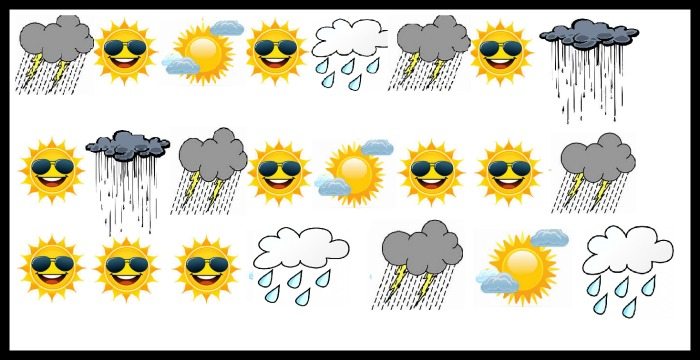
You might experience a little bit more comfortable weather at the end of August.
The majority of morning and evening lows are in the mid to upper 60s F (18 to 20 C), and the majority of afternoon highs are in the mid-80s F. (29-30 C).
Make sure to check our full post on the weather in Washington DC in August for even more information.
Weather in September
Daytime high temperatures in early September will often be in the mid-80s F. (about 29 C).
The likelihood of early morning temperatures in the mid to upper 60s F (about 19 C).
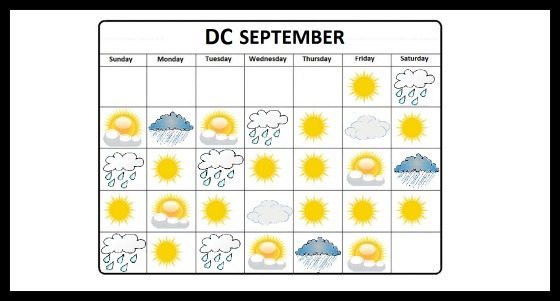
Daytime highs drop to the mid-70s F (about 24 C) by the end of the month, and morning lows often range from the mid to upper 50s F. (about 14 C).
For additional details, make sure to read our full post about the weather in Washington DC in September.
Weather in October
Early on in the month, mild daytime temperatures are to be expected, reaching the low to mid 70s F (approximately 23 C) and, on rare occasions, the 80s F. (about 29 C).
Most morning lows are in the mid-50s Fahrenheit (about 13 C).
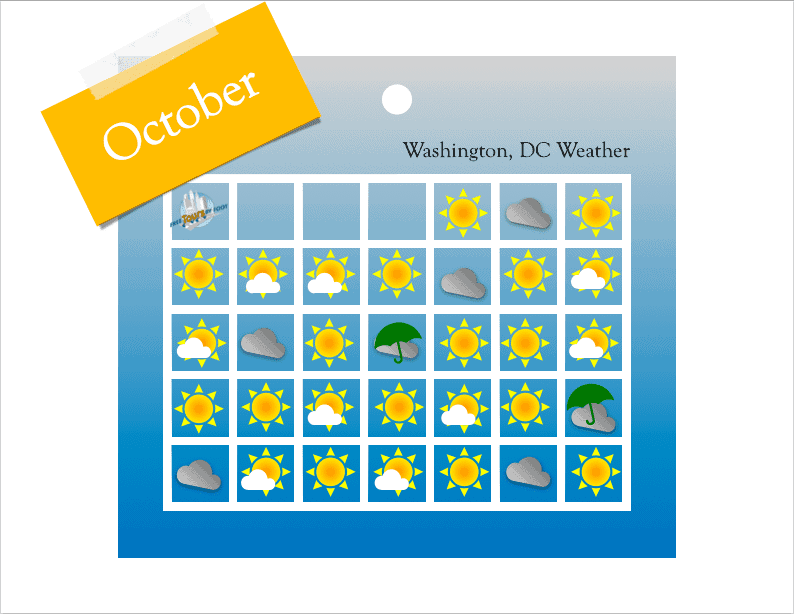
By the end of the month, afternoon highs are more likely to reach the mid to upper 60s F (about 19 C), while temperatures in the should be anticipated at night and in the early morning.
Check our full post on the weather in Washington DC in October for even more information.
Weather in November
Early this month, daytime highs are still in the low to mid-60s F (approximately 17 C), and early morning lows are typically in the mid-40s F. (about 7 C).
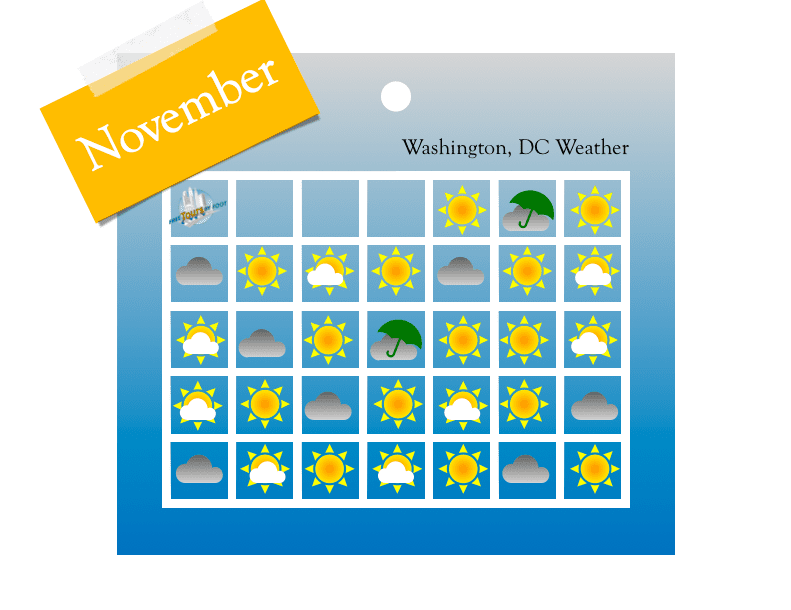
By the end of November, daytime highs are more likely to be in the lower 50s F (10-11 C) and overnight lows in the mid to upper 30s F. Temperatures do decrease progressively over this month (2-3 C).
For more details, check our post covering the weather in Washington DC in November.
Weather in December
Early in December, daytime highs are often in the lower 50s F (11–12 C), with a few of the warmer days having highs of 64 F (about 18 C) or higher.
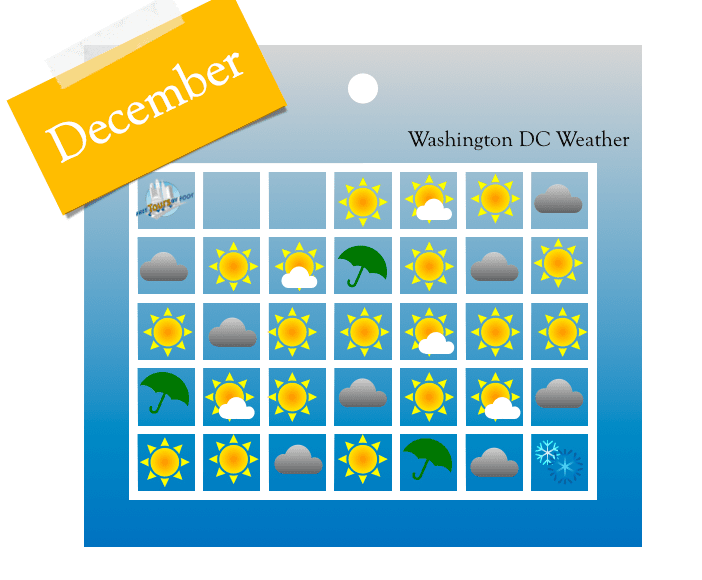
As the month goes on, afternoon highs often drop to the mid-40s F (6-7 C), while morning lows typically range from the upper-20s F to lower-30s F. (-3 C to -1 C).
If you're looking for additional details, please read our post about the weather in Washington DC in December.
What is the Coldest Month in Washington DC
With morning lows in the mid to upper 20s F (-2 to -3C) and afternoon highs in the low to mid-40s F, January is the coldest month of the year in the nation's capital (6 to 7C).
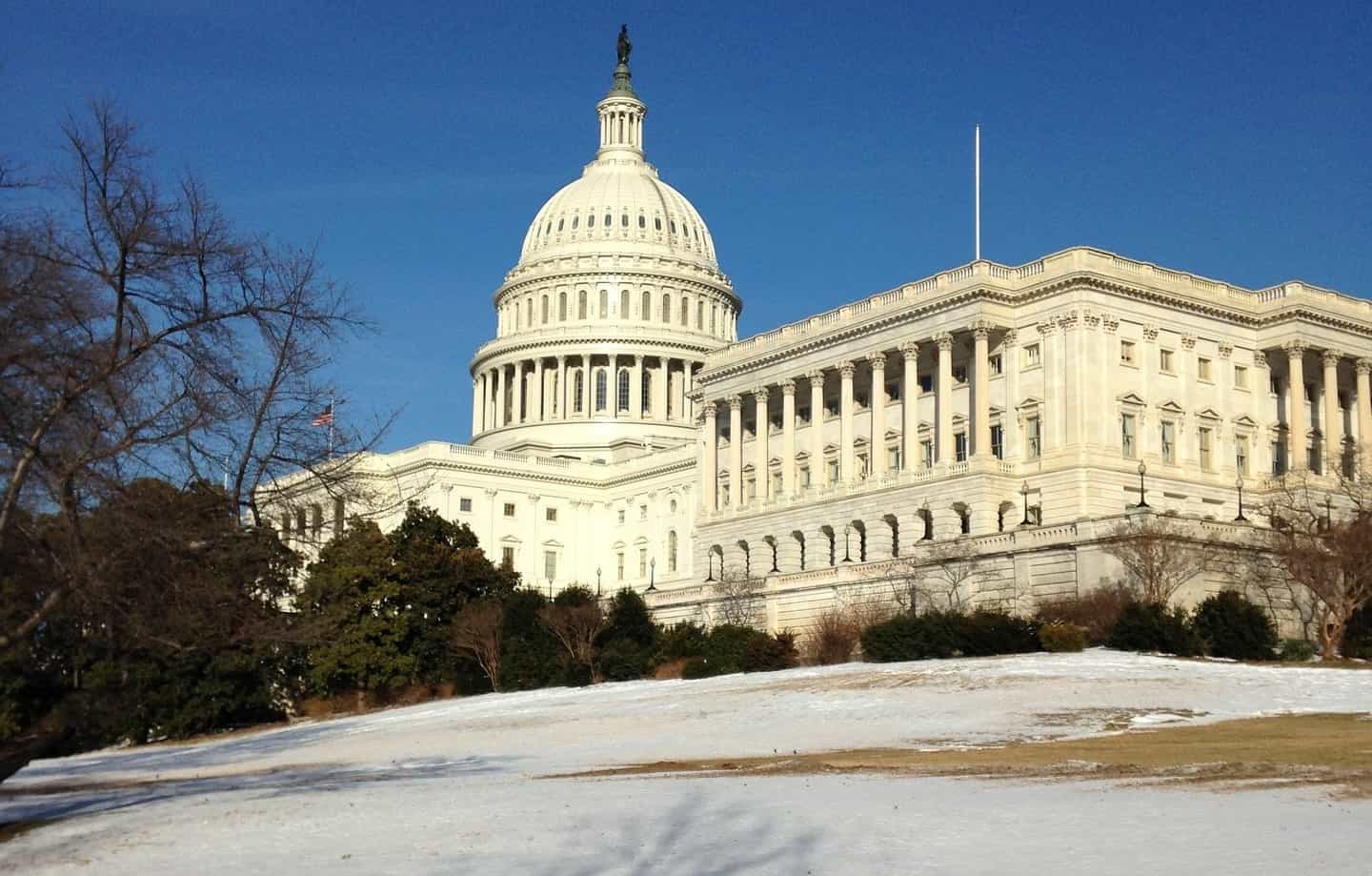
Every ten days, lows will be at or near zero degrees F. (-18C).
That being said, you may anticipate comparable temperatures in February, and the low temperature record for that month is actually 4F. (-15.6C).
When Does it Snow in Washington DC?
The winter months of Washington, DC, from December through February, are typically when snowfall can be expected.
Measureable snowfalls in December often only occur on 1 or 2 days, with snowfalls of at least 1 inch (2.5 cm) occurring once every year or 2 and snowfalls of at least 3 inches (7.6 cm) occurring only about once every 5 years.
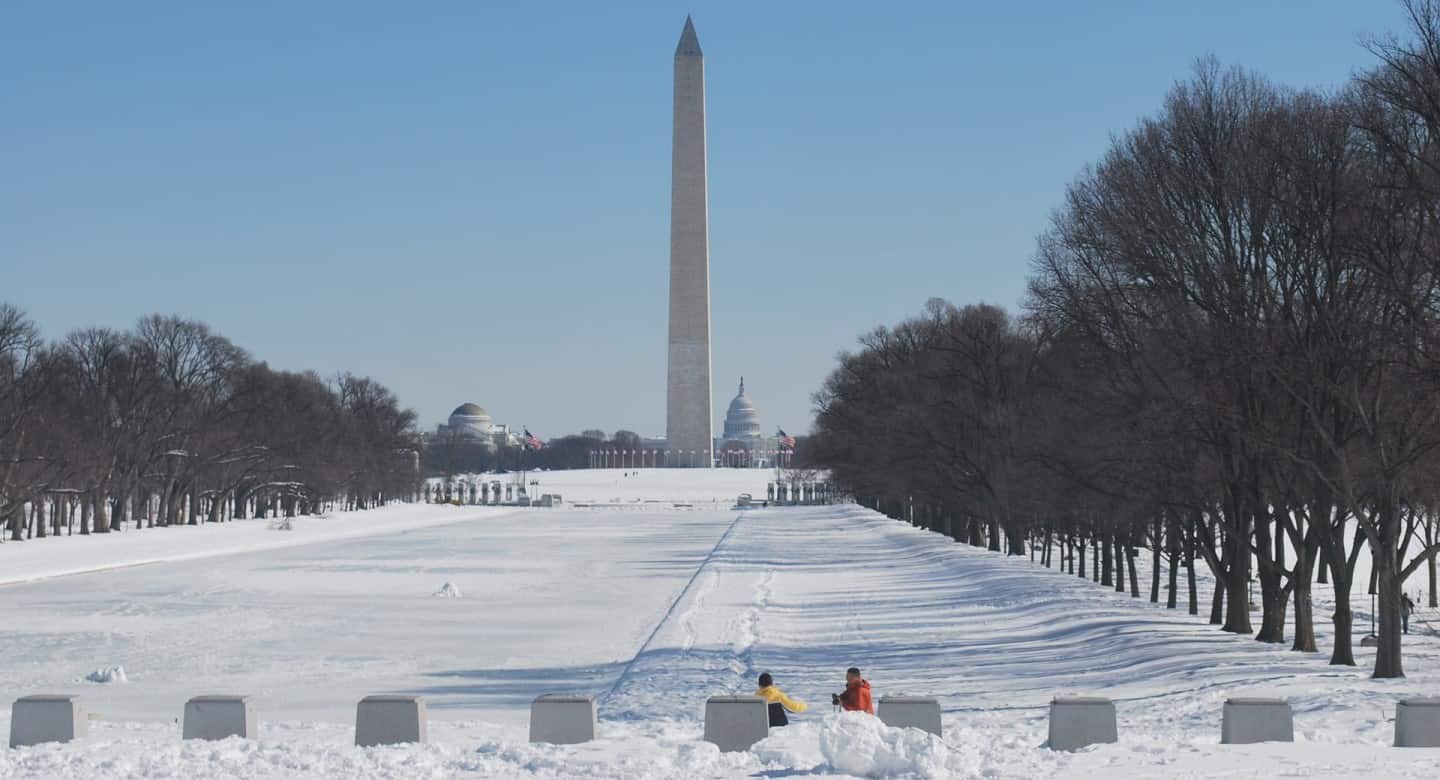
In January, there will be measurable snowfall on about 3 days, and on one or two of those days, there will be at least one inch (2.5 cm) of snowfall.
On average, there will be snow in February, with at least an inch of snowfall forecast on one day.
What is the Warmest Month in Washington DC?
Without a question, July is typically the hottest month in Washington, DC, with many days seeing a high of 90°F (about 32C).
In the past, DC has experienced temperature extremes ranging from 54F (12.2 C) to 104F. (40 C).

Comparatively, June and August both frequently experience more days in the upper 80s F (31-32 C), with a few afternoons reaching 95 F (35 C) or more.
Weather Resources for DC
Since most of our tours are outside, we monitor the weather closely and have come to rely on some key sources of information for planning and getting up to date information.
Capital Weather Gang - this Washington Post group has excellent forecasting, but is great at social media so you're getting updated and often live information. We highly suggest following them on Twitter or subscribing to their forecasts during your trip.
Weather Underground STORM App - this app has a great radar so you can keep an eye on an incoming rainstorms.






